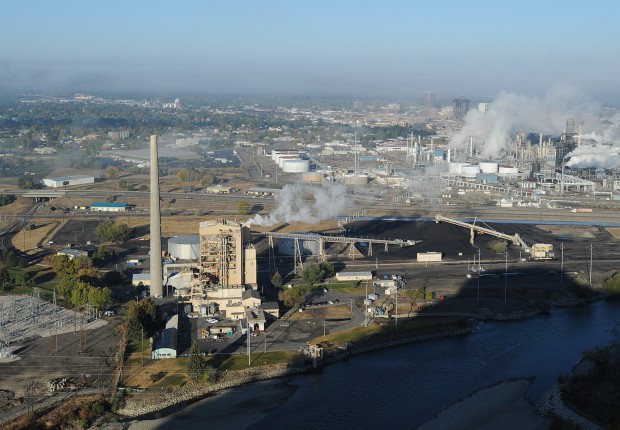DEQ, PPL settle air quality violations
Source: http://billingsgazette.com, June 10, 2013
By: Clair Johnson

Larry Mayer/Gazette Staff
PPL Montana has agreed to install an estimated $10 million in new pollution controls at its Corette power plant.
A settlement of air quality violations with PPL Montana will reduce sulfur dioxide pollution in the Billings area, Montana Department of Environmental Quality officials said Monday.
The legal agreement reached between DEQ and PPL calls for the company to reduce sulfur dioxide pollution in Billings starting in April 2015 by operating control equipment at its Corette coal-fired plant. The controls would cut sulfur dioxide pollution by at least 60 percent.
When the controls, estimated by DEQ to cost $10 million, would actually be installed is uncertain because PPL intends to mothball the Corette plant by April 2015.
PPL also is required to pay a $250,000 penalty and to form a task force at its Corette plant and Colstrip power plants to ensure compliance with opacity regulations. Opacity measures the ability to see through air. High opacity levels obscure visibility and indicate air pollution.
“This meaningful agreement will ensure cleaner air in Billings for years to come,” said DEQ Director Tracy Stone-Manning in a statement.
Sulfur dioxide can cause respiratory illnesses, particularly in children, the elderly and asthmatics.
The agreement was approved on June 6 by District Judge Susan Watters of Billings.
DEQ said PPL did not accurately report sulfur-dioxide related information as required in a 1998 stipulation and as a result, potentially jeopardized information used to show compliance with sulfur dioxide air quality standards.
David Hoffman, PPL’s spokesman, said Monday that the company worked with DEQ to settle the issues and has operated its Corette and Colstrip plants in “an environmentally responsible manner.” PPL also has significantly reduced emissions by investing hundreds of millions of dollars, he said.
For now, however, PPL intends to mothball the Corette plan rather than spend about $40 million to install a bag house necessary to comply with federal air toxics regulations that take effect in April 2015, Hoffman said. A bag house is a device that removes dust. Adding controls to reduce sulfur dioxide pollution would be an additional expense.
Installing a bag house requires a two-year lead time, Hoffman said. Because PPL already is already past that window, the company will mothball the plant, he said.
If market conditions change and PPL decides to resume Corette’s operations, it will have to add controls not only for toxics but also for sulfur dioxide, he said.
PPL announced last fall it planned to mothball Corette, saying it was too expensive to operate under new federal emission reductions and because of depressed wholesale power prices and competition from other power sources. The company employs 35 full-time workers at the 154-megawatt plant, which began operations in 1968.
Hoffman wouldn’t comment on whether PPL intends to sell the Corette plant. However, the settlement requires PPL to notify a buyer of the agreement and for a buyer to agree to its terms and conditions.
Regardless of who may operate the Corette plant in the future, it will have sulfur dioxide controls, said David Klemp, DEQ’s Air Resources Management Bureau chief. Klemp estimated the cost of the sulfur dioxide controls at $10 million.
PPL burns low-sulfur coal and its emissions depend on hours of operation. The plant’s emissions for the past few years have been about 2,100 tons of sulfur dioxide a year. A 60 percent reduction would cut about 1,200 tons, Klemp said.
The settlement also resolved other issues, including running the Corette and Colstrip plants without valid operating permits from August 2010 to January 2013 and for exceeding opacity limits at both plants from January 2008 to the present.
Hoffman said even though the permits had expired, PPL had applications pending and continued operating under the existing permit conditions.
“That really was just sort of a common practice,” he said. DEQ did not tell PPL to stop operations, he said.
PPL respects the agency’s position and cooperated to reach an agreement, Hoffman said.
Hoffman also defended the plants’ opacity compliance, saying they meet the requirements “99.99 percent of the time.” However, there will be a minute or two when the plants, based on operations, will have an opacity violation. “That’s just a fact,” he said.
The 2,100-megawatt Colstrip plant, which is co-owned by five companies and operated by PPL, is the second-largest coal-fired plant west of the Mississippi.
DEQ calculated the penalty for all violations at $376,800, said John Arrigo, the agency’s enforcement division chief. The director decided a $250,000 was an appropriate penalty for missing permit deadlines and to avoid litigation, the agency said.






